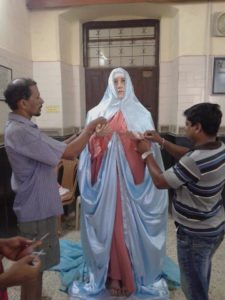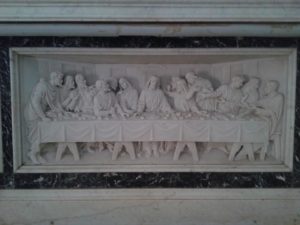
Bandra, a land that both hails the start of mainland India from the once islands of Bombay and currently a suburb of modern Mumbai metropolis, is riddled with interesting facets of ancient and contemporary history that has intertwined and camouflaged itself well into the social fabric of the land.
But among the varied tales that are proudly associated with the Portuguese pride the land still holds through its myriad of markings that are sported by Christian Heritage Relics around every corner waiting to be discovered and admired; there is a tale of a group of missionaries who sailed the unforgiving seas to make a home amongst a fisher-folk whose love and hospitality have led to a large following and the birth of seven parishes within an area of four kilometers.
Among all the Churches that claim to former Portuguese Glory, with age and a collection relics to support their just cause, one church in particular has more than what meets the eye. St Peter’s Church, nestled proudly along Hill Road enroute from Bandra Station to Mt. Mary’s Church, recently celebrated 160 years of its existence. A fact one may initially find it hard to believe considering its beauty and grandeur in romanesque style architecture. Even its central altar has striking similarities with the Saint Stephen Basilica in Budapest.
St. Peter’s Church, started off humbly as a shrine nestled quaintly among fisher folk in the once land called Bandora or Vandra which derives itself from the Urdu word for port. With the advent of the Portuguese in 1505, the first missionaries to set sail to India were the Jesuits or the Society of Jesus whose motto was ad majorem Dei gloriam meaning for the greater glory o God.
The Jesuits were sent in two batches. The first were young priests who hailed from German and Swiss Provinces that heeded to the call to serve the poor and suffering in India. Arriving in 1855 after a turbulent voyage upon the rough seas, their credibility was now being tested as they would now have to face hostility and suspicion in a strange land. They tried their best to prove their worth through hard work including the building of varied structures with minimal resources.
However, later with the outbreak of the First World War, many Jesuit priests were detained at internment camps in various parts of the country while others were repatriated to Germany. The German and Austrian Jesuits were brandished as “Alien Enemies”. Many elder priests lost their lives but they still maintained their simplicity of life and desire to serve writing many a letter including the need for blankets and cutlery and the will to even pay for it while many would sound the SOS.
Filling the void that was now created by the departing German speaking Jesuits, the next wave came in from Spain and arrived in India to fulfill their mission of service, via Karachi in 1921. A testament to the existence of the Spanish Jesuits are two stalwarts of Spanish Origin. First being Fr. Peter Ribes, who at the wise age of 90 has proudly authored several books; Second being Fr. Albert Jou who hailed from a Spanish seminary and now speaks good Gujarathi and the Third being Fr. Francis Juan, born in Valencia, Spain, has become famous for delighting Government Officials with his learnt Marathi when he famously told them “Tumchya peksha mee jaast Indian aahe” [I am more Indian than you].
But more than the priests themselves, the church has a wealth of treasures waiting to be explored ad admired. For example, the stained glass on the windows were designed and made in China by a Spanish Jesuit Brother Antonio Navascues and was shipped to Mumbai. They can be best experienced in the early evenings when the westerly sun lights them up from behind. Even the main altar is made of Carrara Marble. Its facade depicts Leonardo da Vinci’s The Last Supper carved in relief. It was donated by General Franco of Spain. To ensure the Last Supper model would reach in once piece, a duplicate was also dispatched and is kept at the base of the altar of Mt. Mary’s Basilica.
Let us not forget our First Indian Cardinal, Valerian Gracias, now resting at the Wodehouse Church, Colaba, had received his episcopal ordination in this church on 29th June 1946.
Thus Saint Peters is a treasure hidden amongst a growing population who have made a rising concrete jungle that has replaced the quaint Bandra Villages, as their home and has stood the test of time to make its mark as among the worthy Heritage Structures of Bombay. A fact the Government can’t easily ignore.
